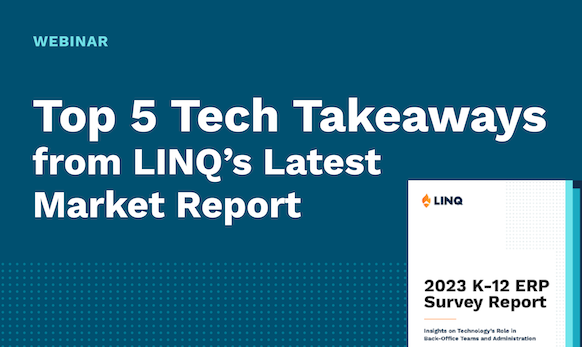Data analytics for schools can help take the mystery out of K‑12 budgeting. With limited resources and the responsibility to provide high-quality education for all students, school districts gain an edge when they can make strategic financial decisions. Data-driven insights offer a powerful tool for optimizing budgeting processes in K‑12 education.
Educators, administrators, and policymakers see the full picture when their data systems provide a holistic, real-time view. They can gain valuable insights into spending patterns, resource allocation, and student outcomes. And that’s just the start. Customized reports and dashboards can help every person in every role make more informed, confident decisions that support school and district goals, priorities, and needs.
The growing demand for data analytics for schools
While well-established in the business world, school systems gathering and using this kind of data in school systems challenges facing K‑12 business professionals, analytics, and business intelligence rank comparatively low in the long list of priorities. Survey results in our recently published 2023 K‑12 ERP Research Report reveal:
- Only 11% of respondents report that data analytics/business intelligence is a top priority
- Only 13% of K‑12 business professionals plan to increase spending on analytics and business intelligence solutions
Insights from real-time data prove crucial for managing crises like the pandemic or trying to maintain district operations during a potentially unstable economic climate. It enables districts to make well-informed choices quickly and adjust as needed—even on the fly. For example, real-time data analytics can provide critical and timely information before a decision is made during a board meeting or at the district office.
5 ways data analytics for schools drive success
- Efficient Resource Allocation: K‑12 decision-makers can more effectively manage resources thanks to data-driven insights. For instance, investing funding for increased classroom teacher training becomes a priority if data show many students are having difficulty in a specific topic. In isolation, maintenance concerns for a particular structure could appear minor. Nevertheless, they might mount up and indicate the necessity for more substantial repairs or a reorganization of the district’s budget across various facilities. Districts may optimize their effect and ensure that every dollar spent improves educational outcomes by matching resources with student needs. It becomes crucial to have visibility into the budget, the available finances, and the employees.
- Evidence-Based Decision Making: K–12 decision-makers can make budgetary decisions based on solid facts thanks to data-driven insights. Districts might find trends, patterns, and inefficient regions by examining historical financial data. For instance, decision makers may immediately identify and reallocate funding to efforts that have proved to be more effective if data suggests that a certain program typically has low student involvement and low impact. Data removes uncertainty and guarantees that budgetary choices are supported by verifiable facts, resulting in more efficient resource allocation and improved student results.
- Identifying Cost-Effective Strategies: Districts may find cost-effective plans and initiatives using data-driven insights. Decision-makers can assess the return on investment (ROI) of different projects by looking at statistics on program expenses and student results. This data makes it easier to pinpoint the initiatives with the best return on investment. As an illustration, let’s say research reveals that a particular tool or technology dramatically raises student performance while being comparatively affordable. In such circumstances, decision-makers may analyze the budget and decide which projects should be funded and expanded first. With the use of data-driven budgeting, districts may make decisions that optimize educational value while reducing budgetary stress.
- Predictive Modeling for Future Planning: Districts can use predictive modeling for upcoming planning and budgeting thanks to data-driven insights. Districts can predict issues and foresee future trends by evaluating historical data. For instance, if enrollment trends in specific grade levels are growing, decision-makers might devote resources to meet the anticipated increase in student enrollment. Administrators might likewise imagine similar outcomes if finances suffer due to falling enrollment. Districts may foresee requirements, prepare for emergencies, and distribute resources proactively with the support of data-driven projections, eliminating last-minute changes and guaranteeing budget stability.
- Transparency and Accountability: Data-driven budgeting enhances transparency and accountability in K‑12 education. By using data to inform budgetary decisions, districts can provide clear justifications for resource allocation. Transparent budgeting processes build trust among stakeholders, including parents, teachers, and community members. Moreover, data-driven insights allow districts to track the impact of their budgeting decisions on student outcomes. This accountability ensures that resources are used effectively and efficiently, focusing on improving student achievement.
Accelerate school success with data-driven K‑12 decision making
In the face of limited resources and the ever-increasing demand for quality education, data-driven insights have become an invaluable asset for budgeting in K‑12 education. When prioritized at the leadership level, implementing a data-driven culture can significantly impact a district’s ability to manage its performance proactively, pivot when circumstances change, and prepare itself for future success.
By leveraging data, decision-makers can efficiently allocate resources, make evidence-based choices, identify cost-effective strategies, engage in predictive modeling, and foster transparency and accountability. Data-driven budgeting maximizes the impact of available resources, ensures alignment with student needs, and ultimately leads to improved educational outcomes for all learners.
Get the top takeaways from our K‑12 operations and data deep dive
We distilled the most important takeaways from our operations report featuring survey results, expert analysis, and technology’s role in supporting educational success. Watch this webinar to learn what K‑12 finance, HR, and technology leaders need to know.

